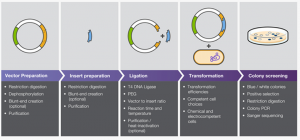One way we intend to examine the role of our target proteins, CG and Flapwing (flw) is by RNA interference knockdown (RNAi, in which the target proteins are inhibited in live cells, those cells exposed to the apical constriction signaling ligand, Fog, and the cells fixed so their response may be quantified. But in addition to knockdown, we also plan to measure target overexpression and localization. To these ends, we will use recombinant DNA techniques to produce clones of our target proteins’ coding sequences, in the form of a synthetic vector.
The process of producing a vector applicable to the proteins of interest first requires that template DNA of both targets are amplified by polymerase chain reaction (PCR). Once the DNA has been scaled up, it is precipitated and resuspended in water before being “digested” by two specialized restriction enzymes that sever the DNA at specific locations in sequences artificially inserted into the coding gene for the target proteins.

Because the cleavage sites on any two antiparallel sites cut by the same restriction enzyme will be complimentary, it is possible to place complimentary cut sites on both our insert and a cloning vector (pMT/V5-His A), thus allowing the cloning vector’s cut ends to match to the cut ends of our insert and for the two to bind. The process of combining vector and insert and encouraging them to bind and circularize is known as ligation.
Once ligation is complete and the insert DNA has been successfully added to the vector, the product is introduced to a bacterial culture and allowed to propagate before the culture is spun down by centrifuge and the DNA is isolated, for further use in increasing the expression of our target proteins in cell culture.

Due to difficulties with the cloning procedures, we are still currently attempting to successfully force the vector to take up the insert and vectorize the genes of our target proteins, which is necessary to introduce this increased protein expression into cell cultures. We have as such added CIP to the PMT His-A digestions, which prevents the vector from re-forming with itself and requires the binding of the insert for the DNA to circularize, and are expecting better results from our ligations in the future.
References:
- Molecular Cell Biology. 4th edition. Lodish H, Berk A, Zipursky SL, et al. New York: W.H. Freeman; 2000
- Thermo Fisher Scientific (2018). Traditional Cloning Basics | Thermo Fisher Scientific – US.
